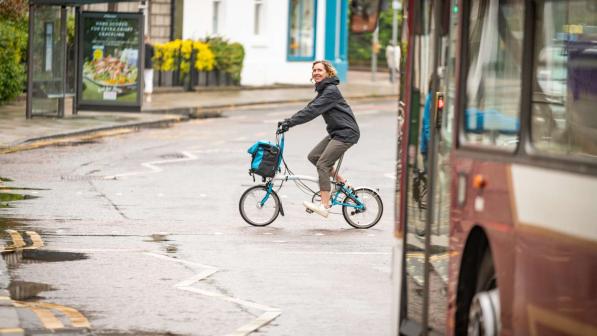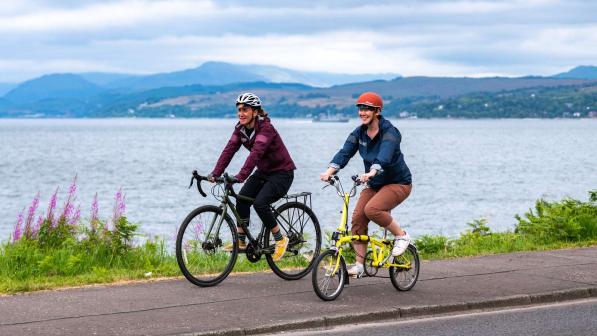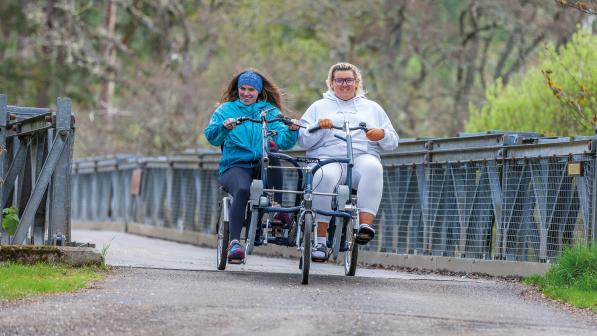Great rides: Brittany by Brompton

Bikes folded nearby, we sat in the mid-morning sunshine at a café in Roscoff, Brittany. Behind us was a group of animated young people with cabin cases, who were smoking and drinking. It was only when one of them gave a cheery “Hello” that I realised that they were the crew from the overnight ferry we’d caught from Plymouth. Having arrived at 6.30am, we’d already explored the town centre and a local beauty spot before settling down to a beer and brunch ourselves.
My partner Celia and I were on a new adventure, aiming to cycle the small roads of the Brittany coastline from Roscoff to Saint-Malo, across Normandy to Caen, then take a train to Paris and the Eurostar home. The pandemic had disrupted our plans to cycle Route 66 from Los Angeles to Albuquerque so we’d used our holiday money to buy customised Bromptons with Rohloff hubs and disc brakes. They were certainly special but how would they cope with a two-week tour?

Tickets to ride
We felt pretty smug cycling to our local station, folding the bikes and shouldering our two pieces of luggage for a journey on the Elizabeth Line to Paddington. We were even more smug when we did the same thing to board a GWR train to Plymouth, avoiding the need to reserve one of the (maximum) four bike spaces available on its intercity trains.
Our luggage was minimal. We each had a front bag, plus a trunk bag for the rear carrier. Celia seemed to carry more in her 14-litre front bag than I managed in my 25-litre one. But our limited luggage capacity meant no camping gear. We were taking a chance on early-season hotel availability.
Check-in at the Brittany Ferries terminal was straightforward, and we boarded with foot passengers, the bus dropping us next to a lift on the car deck. On board, the bikes were safely stored in the ship’s luggage locker. The ferry’s dawn approach to Roscoff was lovely. As the medieval town was still asleep, we decided to explore a little. We cycled along deserted roads to the Pointe de Perharidy, a peninsula with beautiful wild beaches and great views across the bay to the distant town.
Back in Roscoff, after an early check-in at our hotel, we were ready for a beer and a sandwich. The café favoured by the Brittany Ferries crew was a good choice, facing a harbour from which small ferries (vedettes) ran boat trips to the nearby Île de Batz. It was €10 return, dogs free and bikes €16. It was worth taking our bikes with us to explore the island… and get lost, despite its small size. There’s a spectacular botanic garden on the Île de Batz – and another on the mainland, just up the road from the ferry terminal.
Before we left Roscoff we had somewhere we had to see: the Maison des Johnnies & de l’Oignon de Roscoff, a small museum telling the story of the bike-riding ‘Onion Johnnies’, with their strings of onions that they delivered to British households. It brought tears to our eyes.
Biking through Brittany
Next day we set out on small lanes for Morlaix, keeping the sea in view where possible. It was a pleasant ride past fields spiky with artichokes, and we arrived at the port in time for lunch. The approach along the river was scenic, as was Morlaix itself, located in a deep ravine spanned by a majestic railway viaduct. Unfortunately, cars dominated the town. Fumes and parked vehicles spoiled our search for historic half-timbered houses. We were forced to take refuge in a bar.
Our hotel, like many places we visited, had bikes for hire, mainly electric assist. In the hotel, Celia, an inveterate investigator of tourist leaflets, spotted some about bicycle routes in the area. We realised that my hours poring over Google Maps had been unnecessary. We could simply take EuroVelo 4, La Vélomaritime, which followed the French coast from Roscoff to Dunkirk.
We downloaded the route to our phones but also picked up paper copies wherever we could, usually from tourist offices. We both like a paper map. The route maps showed which sections were on road and which were off road, and whether they were suitable for families or challenging for all. Also signalled were ‘dénivelé important’ (tough hills). There were quite a few of these, which for me usually invoked another warning: ‘pied à terre’ (walk it)!
It was a good reminder that, in hilly terrain, fitness isn’t optional even with an 18in bottom gear. Those hills were presumably why we encountered so many happy, smiling cyclists riding electric bikes, looking just like they do in the adverts. I often felt envious. Yet a couple of times we did come across traditional, fully-loaded, grey-bearded cycle tourists struggling up long inclines. I wanted to cheer, in awe of their strength and determination (and envious of their camping gear).
We booked our first two hotels but for the rest of the trip we estimated where we would be two days ahead and used Google Maps to identify places to stay. Sometimes hotels were scarce. Campsites were plentiful – and French campsites are great, aren’t they? – so we missed having a tent to fall back on.
Food was rarely a problem. We did most of our cycling in the morning, and Brittany is loaded with crêperies for a bite and a beer at lunchtime. The craft beer revolution hit France later than the UK but many places now have a local brewery offering hit-and-miss IPAs. In one hotel, catering largely for walkers doing the coastal trail, the menu’s prices looked promising but turned out to be for something pre-prepared in a jar, like big baby food. Fortunately, the beers and wine were fine.
Coasting along
We kept on moving around the coast – Paimpol, Saint-Brieuc, Val-André – on a mixture of quiet roads, farm tracks, dedicated cycle paths and overgrown trails. At Matignon I had the only puncture of the trip, a slow one that held air until we made it to our hotel. I fixed it with the hovering help of the hotelier, a man with a set of tools and a mechanical bent who nodded his approval as I sealed the hole in the tyre with superglue. A German cyclist staying at the same hotel, doing 100 miles or more every day on a lovely bike he’d built himself, tipped us off that we could divert to Dinard before the Vélomaritime crossed the Rance river. There we caught a ferry to Saint-Malo, arriving by boat at another spectacular French port.
We weren’t the only cyclists. The morning arrival of the Portsmouth ferry had deposited a phalanx of British cycle tourists, who were relaxing over coffees in the sunshine, keeping an eye on their steeds stacked against the ancient city walls. I was taken by an electrified Flying Gate, which was festooned with spare tyres, wing mirrors, multiple locks, a pump lock (!), bungees, a monkey mascot and a clothes peg on the brake cable. None of your lightweight bikepacking nonsense here. Every eventuality covered – a touring cyclist after my own heart.
The météo was forecasting a storm for the following day, accurately as it turned out. Leaving Saint-Malo we wore wet weather gear for the first and only time during our trip. The rain eased pretty quickly, and by mid morning we were cycling past the Cançale oyster huts under a cloudy sky punctuated by the kites of happy windsurfers. Mont-Saint-Michel was a blip on the horizon.

Normandy ending
We gave Mont-Saint-Michel a miss. Magnificent from afar, up close it’s an expensive tourist trap selling expensive tourist tat. Instead we spent Sunday afternoon in Pontorson, which was cheap but not cheerful. The hotel had the nerve to add an extra €10 to our bill for storing the bikes overnight in an outhouse. In retrospect, the magnificent tourist trap might actually have been a better bet.
At least we had a decent meal, whereas the following day we fell foul of French Mondays. After the Sée estuary at Pontaubault, the Vélomaritime climbs steadily into the Normandy countryside on a greenway. Part of this is a small engineering miracle: the former Fougères to Vire railway, which winds its way upwards (2,700ft in two days for us) through a very hilly region without bridges or tunnels.
A scrappy breakfast at our hotel (another €10 each) left us desperate for lunch so we dropped off into Saint-Hilaire-du-Harcouët and were lucky to find a boulangerie open. They happily made us sandwiches – in wraps, the only bread they had left. In the evening at Mortain-Bocage not a single restaurant was open. Fortunately, a small épicerie provided the essential victuals: wine, cheese, crisps and a plastic sandwich. French Mondays!
We left the Vélomaritime at Sourdeval, heading back across country to the coast at Caen, where we boarded a train to Paris. From Gare Saint-Lazare we had a thrilling ride across to Gare du Nord, where, folding the bikes again, we caught the Eurostar home. Yippee for the folders!
Cycle magazine
Every two months Cycling UK members receive Cycle magazine, filled with interesting and informative articles, news and reviews for all cyclists.
Members can read the magazine in full online; non-members can read selected highlights.


